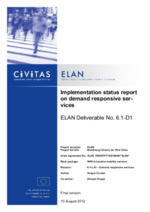Demand-responsive services
Thematic areas
Collective passenger transport & shared mobility
- Ride sharing
- Car sharing
- Bike sharing
- Accessibility
- Intermodality
- Ticketing and tariffs
- Service improvements
Summary
Ljubljana is setting up a demand-responsive public transport service to meet the mobility needs of all people, especially those with disabilities. Thereby it is the first city in Slovenia to develop a demand-responsive public transport services system with the possibility to later on apply the service to low-density areas more widely.
Implementing sustainable mobility
The main objective of the measure was to ensure mobility for people with disabilities. To be more precise:
- To implement the best solutions to operate an innovative and flexible demand-responsive public transport system to serve the mobility needs of impaired people;
- To promote legislative and other activities aimed at granting impaired people equal access to public mobility services;
- For test purpose introduce system (bus on demand) on regular bus line which has low frequency or no service at all;
- Establish new connection between zone for pedestrians and regular bus line to improve the mobility also for other PT users;
Before ELAN, the impaired people's mobility needs were satisfied only through associations that provide transport services only to their members so there was a lack of accessible transport for non-members and other people visiting Ljubljana.
Progress
The public transport operator LPP has made huge efforts to offer to people with disabilities a possibility to use, practically on their entire bus fleet, a public service regardless of their disability. A contribution to social inclusion and self confidence of disabled was an extremely important effect of this decision. It led to a change in obligatory elements and performance of all new buses to be purchased, that should meet all needs of disabled and, of course, an introduction of new type of trainings for the LPP staff, having in mind that different disabilities are in need of different approaches depending of help required. Implementation of different communication channels (web, smart-phones, etc.) among user of PT and PT operator was implemented in order to offer or order transport service on demand. All efforts and activities are user friendly and oriented to provide optimal service and information flow between users and a PT provider. As a result of changed approach LPP has initiated and established cooperation with many organizations representing different types of disabilities. For a start, an application was developed, a test period was concluded and changes were performed regarding feedback from the users. User suggestions and remarks were taken into consideration during development regarding PT provider possibilities.
Beside (pretty common in the EU countries and elsewhere) use of PT by people with sensor disabilities (blindness, deafness), LPP has introduced a service that to LPPs best knowledge has not been performed by any other PT operator worldwide. In cooperation with an educational institution “Janez Levec” in Ljubljana, taking care of youngsters with mental disorders, LPP has introduced a system that after due preparation and training enables passengers with Down syndrome and autism to use PT on their own. At a moment a 6 person group with these types of mental illnesses regularly uses PT on their ways to school, work or leisure. Entering like all other passengers at driver’s entrance, they just show to the driver their card with short info on them, a name of a contact person (if needed) and their destination. Seated close to the driver, they are during the ride under his discreet and trained supervision. Improved self confidence, satisfaction and better social inclusion of these individuals are very nice side effects. Preparation of a new, small group of “Janez Levec” students is ongoing. After special training, they joined the initial group in September 2013.
Outcomes
Key result 1 – Increase in use of Kavalir, but not for software based demand responsive service
Before the full implementation of the demand responsive service (in January 2012), 17 impaired people were using the PT service, while only 3 of them being registered in the system. After the full implementation and operation of the software tool this number increased and all 17 impaired persons are using the software based demand responsive service are registered users (August 2012). Basically, the acceptance of demand responsive service by impaired people did not change: altogether 17 persons before and also after (target value of 30% increase was not achieved). The reason might be, that due to a very late implementation of the system, the dissemination activities could not attract new users that would register into the demand responsive software system (the target has not been achieved). However, new users have been seen to be using the PT features for the impaired people, but without registering into the system (wheelchair users can use the PT web service to learn, when the low floor bus will be arriving at the bus stop). The number of Kavalir users on the other hand increased significantly, from 70 users per day to 300 users per day (the target has been exceeded). It can be assumed that the increase would be less significant without CIVITAS. Part of the increase is the impact of the related dissemination within CIVITAS and the partnership between COL and LPP, which enabled that the shuttle was allowed to access in the entire pedestrian area.
Key result 2 – Users satisfied with new services
None of the 17 regular and occasional users reported any issues that required further attention. This is interpreted as a 100% satisfaction. The target has been exceeded. The customer satisfaction with Kavalir increased by 4% within one year, and the satisfaction was exceeding the target value of 75% immediately after implementation (score 4.42 out of 5).
Key result 3 – Improved attitude of drivers
The assistance of drivers willing to assist impaired people increased from 50% to 95% (target of 15% was exceeded).









